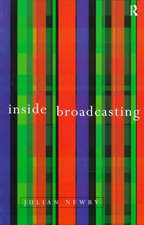Digital Technology and the Future of Broadcasting: Global Perspectives: Electronic Media Research Series
Editat de John V. Pavliken Limba Engleză Hardback – 22 iul 2015
Among the many issues covered are:
- The impact of digital technology on the structure of broadcasting organizations and regulation;
- The nature of broadcast content or media programming and how it is delivered at home and abroad;
- Engagement and interaction of the public with broadcasting and social and mobile media; and
- The reshaping of revenue models for broadcasters and media organizations globally.
As a benchmark of the remarkable changes taking place in today’s media environment, the volume sets an agenda for future research on the implications of digital technology for broadcasting and broadcasting education.
| Toate formatele și edițiile | Preț | Express |
|---|---|---|
| Paperback (1) | 389.66 lei 6-8 săpt. | |
| Taylor & Francis – 10 dec 2019 | 389.66 lei 6-8 săpt. | |
| Hardback (1) | 1164.44 lei 6-8 săpt. | |
| Taylor & Francis – 22 iul 2015 | 1164.44 lei 6-8 săpt. |
Preț: 1164.44 lei
Preț vechi: 1420.05 lei
-18% Nou
Puncte Express: 1747
Preț estimativ în valută:
222.83€ • 230.22$ • 185.36£
222.83€ • 230.22$ • 185.36£
Carte tipărită la comandă
Livrare economică 19 martie-02 aprilie
Preluare comenzi: 021 569.72.76
Specificații
ISBN-13: 9781138891227
ISBN-10: 1138891223
Pagini: 252
Ilustrații: 17 black & white tables
Dimensiuni: 152 x 229 x 18 mm
Greutate: 0.48 kg
Ediția:1
Editura: Taylor & Francis
Colecția Routledge
Seria Electronic Media Research Series
Locul publicării:Oxford, United Kingdom
ISBN-10: 1138891223
Pagini: 252
Ilustrații: 17 black & white tables
Dimensiuni: 152 x 229 x 18 mm
Greutate: 0.48 kg
Ediția:1
Editura: Taylor & Francis
Colecția Routledge
Seria Electronic Media Research Series
Locul publicării:Oxford, United Kingdom
Cuprins
Series Editor’s Foreword
Introduction
Part I: Research Challenges in a Changing Broadcast Environment
Chapter 1
Backchannel Communication Motives in Predicting Social Presence and Sports Channel Commitment during the First Social Media Olympics
YoungChan Hwang, SBS (Seoul Broadcasting System) and Joon Soo Lim, Syracuse University
Chapter 2
Double Vision: An Eye Tracking Analysis of Visual Attention between Television and Second Screens
Miao Guo, Ball State University and Michael Holmes, Ball State University
Chapter 3
Twitter and Television: Broadcast Ratings in the Web 2.0 Era
Michael Brouder, Ball State University and Robert Brookey, Ball State University
Part II: Research Issues and Advances in Global Broadcasting
Chapter 4
Broadcast and New Media Use in China: Findings from a National Survey
Fei Shen, City University of Hong Kong; Zhian Zhang, Sun Yat-sen University; and Mike Zhengyu Yao, City University of Hong Kong
Chapter 5
Sensational Pictures: An Analysis of Visual Structure on Five Transnational Arab News Channels
Michael D. Bruce, University of Alabama
Chapter 6
Telepresence and Immersion with High-Definition Digital Displays: Background and Future Directions for Research
Peter Seel, Colorado State University
Part III: International Perspectives on Broadcasting in the Digital Age
Chapter 7
The Future of Television: An Arab Perspective
Joe Khalil, Northwestern University in Qatar
Chapter 8
Tourism as a mediated practice in a global media context: The gaze of female Korean tourists to New York City and the meaning of their practices
Eunkyung E.K. Lee, Social Innovation Center, The Hope Institute
Chapter 9
Assessing the role audience plays in digital broadcasting today and tomorrow
Dwight DeWerth-Pallmeyer, Widener University
Chapter 10
Digital broadcasting and the Media Monitoring System
Randolph Kluver, Texas A&M University
Chapter 11
Diversity in digital media at home and abroad
Naeemah Clark, Elon University
Chapter 12
The Legacy of Dr. Horrible: Potential Research into Second-Screen Intrusion, Coordination, and Influence
Tim Hudson, Point Park University
Chapter 13
Changing Paradigm
Mitchell Shapiro, University of Miami
Chapter 14: Concluding Reflections
Ok Glass:’ Implications of Wearable Technologies for the Future of Broadcasting
John V. Pavlik, Rutgers University
Introduction
Part I: Research Challenges in a Changing Broadcast Environment
Chapter 1
Backchannel Communication Motives in Predicting Social Presence and Sports Channel Commitment during the First Social Media Olympics
YoungChan Hwang, SBS (Seoul Broadcasting System) and Joon Soo Lim, Syracuse University
Chapter 2
Double Vision: An Eye Tracking Analysis of Visual Attention between Television and Second Screens
Miao Guo, Ball State University and Michael Holmes, Ball State University
Chapter 3
Twitter and Television: Broadcast Ratings in the Web 2.0 Era
Michael Brouder, Ball State University and Robert Brookey, Ball State University
Part II: Research Issues and Advances in Global Broadcasting
Chapter 4
Broadcast and New Media Use in China: Findings from a National Survey
Fei Shen, City University of Hong Kong; Zhian Zhang, Sun Yat-sen University; and Mike Zhengyu Yao, City University of Hong Kong
Chapter 5
Sensational Pictures: An Analysis of Visual Structure on Five Transnational Arab News Channels
Michael D. Bruce, University of Alabama
Chapter 6
Telepresence and Immersion with High-Definition Digital Displays: Background and Future Directions for Research
Peter Seel, Colorado State University
Part III: International Perspectives on Broadcasting in the Digital Age
Chapter 7
The Future of Television: An Arab Perspective
Joe Khalil, Northwestern University in Qatar
Chapter 8
Tourism as a mediated practice in a global media context: The gaze of female Korean tourists to New York City and the meaning of their practices
Eunkyung E.K. Lee, Social Innovation Center, The Hope Institute
Chapter 9
Assessing the role audience plays in digital broadcasting today and tomorrow
Dwight DeWerth-Pallmeyer, Widener University
Chapter 10
Digital broadcasting and the Media Monitoring System
Randolph Kluver, Texas A&M University
Chapter 11
Diversity in digital media at home and abroad
Naeemah Clark, Elon University
Chapter 12
The Legacy of Dr. Horrible: Potential Research into Second-Screen Intrusion, Coordination, and Influence
Tim Hudson, Point Park University
Chapter 13
Changing Paradigm
Mitchell Shapiro, University of Miami
Chapter 14: Concluding Reflections
Ok Glass:’ Implications of Wearable Technologies for the Future of Broadcasting
John V. Pavlik, Rutgers University
Notă biografică
John V. Pavlik is professor in the Department of Journalism and Media Studies at the School of Communication and Information, Rutgers, the State University of New Jersey.
Descriere
Addressing international issues of technological change and considering the implications for broadcasting and electronic media globally, this volume spotlights the impact of digital technology on the structure of broadcasting organizations and regulation; the nature of broadcast content or media programming and delivery; the public’s engagement and interaction with broadcasting /social/mobile media; and reshaping revenue models for broadcasters and media organizations.

































